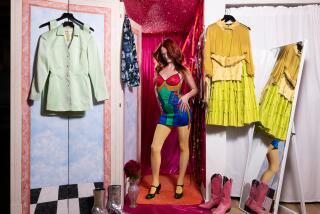BACK TO THE BLUES BASICS
- Share via
While some denim brands are pushing the trends this fall -- giving blue jeans motocross details, quilting finishes or leather-like coatings -- two of the biggest players are looking back instead of forward. Levi’s and Gap are both mining their archives and leveraging a nostalgic longing for decades past.
The most high-profile effort is Levi’s relaunch of its Orange Tab collection in mid-August. Produced from 1969 through the late 1970s, the line was created as a less expensive offering for the burgeoning youth movement of the time. According to company lore, the lower price and a manufacturing process that allowed Levi’s to quickly adapt to changing styles (first slim and skinny, later with flared legs) made a huge success of the jeans, which bore a Levi’s orange tab logo affixed to the pocket in place of the traditional red one.
For the re-created version, the company has gone to great lengths to duplicate every exacting detail from the original manufacturing process, from the fabric “recipe” (a specific 14-ounce, wide-loomed denim made by Cone Denim in North Carolina) to forgoing its famous rivet details in favor of bar tack stitching. Perhaps the only detail of the collection that isn’t duplicated is the lower price point -- Orange Tab 2.0 is positioned as a premium product, with five-pocket jeans retailing from $205 to $225 at launch. T-shirts are priced at $98; button-front, western-style denim shirts are in the $180-$198 range, and a 1970s-era trucker jacket (the priciest of the inaugural offerings) clocks in at $288.
Part of the higher price tag follows from Levi’s decision to duplicate the original line’s made-in-the-U.S.A. pedigree by manufacturing the entire collection domestically. “Everything in the Orange Tab collection is [cut and sewn] in Southern California,” said Miles Johnson, creative director of the premium Levi’s collection. “It’s something we’re extremely proud of.”
The silhouettes are simple (a 1960s’ skinny leg designated the 606, a 1970s’ regular fit called the 615 and a 1970s’ bootcut called the 607), the range of washes uncomplicated, and there’s nary an embellishment to be seen.
In a zen-denim way, it’s precisely what’s not there that Levi Strauss & Co. hopes resonates with today’s denim consumer.
“What we’re finding is that people are so overloaded with options on denim, all the brands, all the [different] things,” says Miles Johnson, creative director of the premium Levi’s collections. “In essence, Orange Tab jeans are a very simplified construction of a five-pocket Levi’s jean.”
To launch the collection, Levi Strauss & Co. re-created the vibe of the times as painstakingly as it did the product itself, publishing “Zipper,” a 60-page faux music magazine circa 1972 crammed with vintage Levi’s ads; launching a period-appropriate online radio station called KLVC; and staging a music festival on a 40-acre Topanga Canyon estate last weekend.
The Gap, which opened in 1969 at the corners of Haight and Ashbury and has long leveraged its roots, recently announced it too would be looking to the past with a fall ad campaign called “Back to Blue.” According to Gap’s global chief marketing officer, Seth Farbman, the campaign is about “getting back to what matters most, our truest selves, when we are most comfortable in our own skin.”
The campaign includes tapping 24 “influential millennials” (bloggers, reality TV stars, stylists) to share their stories “about what it means to be one’s most authentic self” in short video clips, photos and animated GIFs, in support of a fall collection grounded in Gap’s 1969 denim program. The collection is a range of simple, slim-fitting jeans for men and women (retailing from $60 to $90), button-front chambray and denim shirts and a variety of denim jackets.
With fall collections just hitting stores, it’s far too early to tell how the two companies’ efforts will ultimately resonate at the register, but one thing’s certain: If either Levi’s back-to-basics merchandise mix or Gap’s earnest, soul-baringly authentic ads manages to cut through the indigo clutter and connect with consumers, expect other denim labels to follow suit.
Of course to authentically mine a company’s heritage circa the late 1960s or early 1970s, it would be best for it to actually have existed then, and there’s not an awfully deep bench of brands that had boots -- or bootcuts -- on the ground back in the day.
Which could make Levi’s and the Gap’s “back to the future” strategy for fall 2013 nothing short of true blue genius.
--







